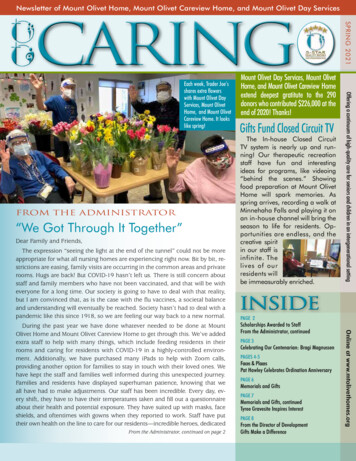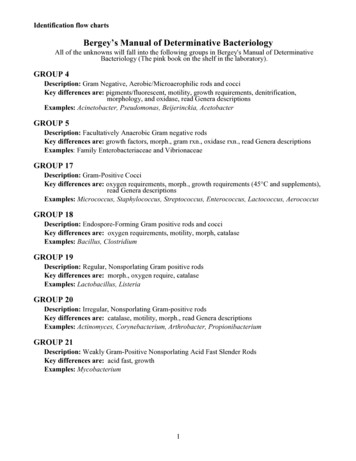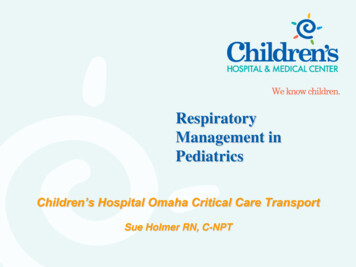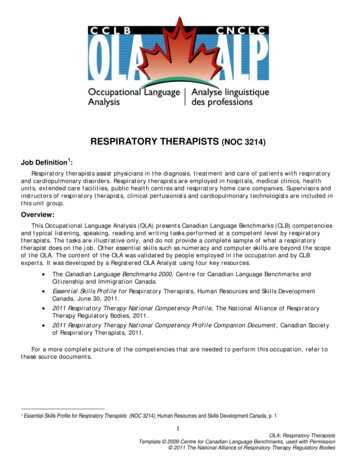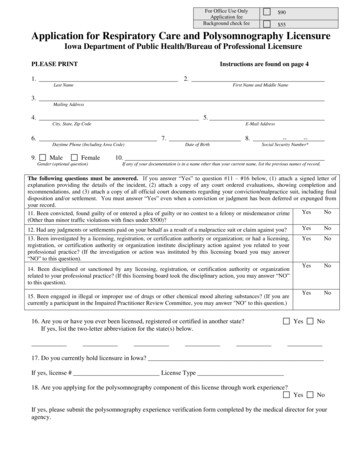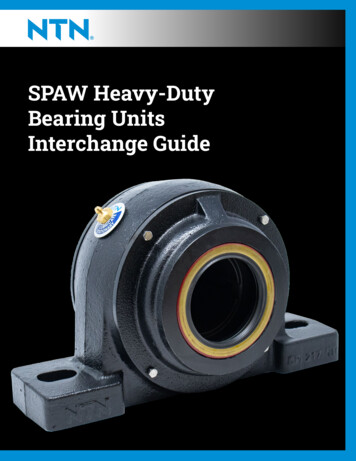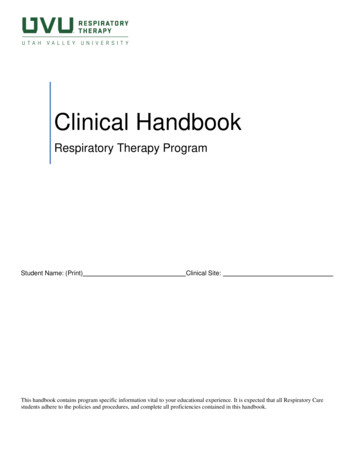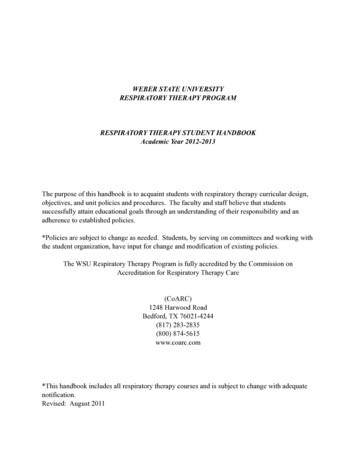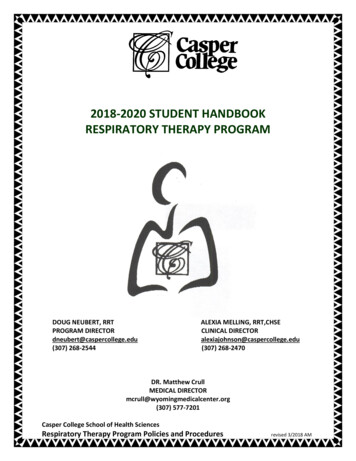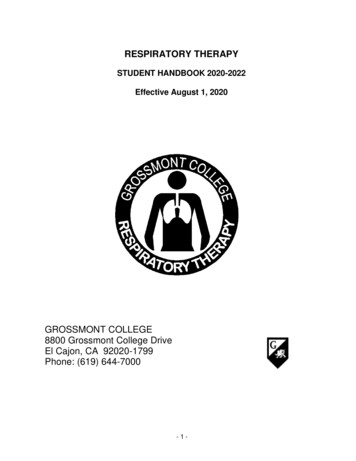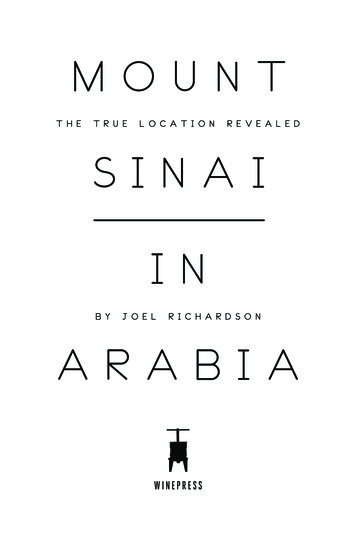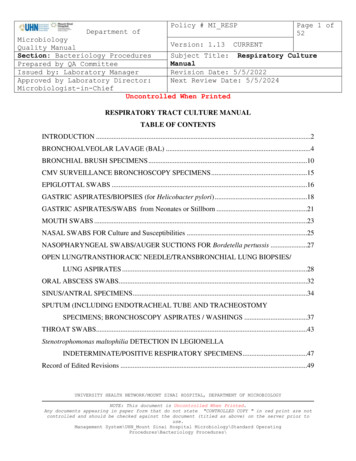
Transcription
Department ofPolicy # MI RESPPage 1 of52MicrobiologyVersion: 1.13 CURRENTQuality ManualSection: Bacteriology ProceduresSubject Title: Respiratory CultureManualPrepared by QA CommitteeIssued by: Laboratory ManagerRevision Date: 5/5/2022Approved by Laboratory Director:Next Review Date: 5/5/2024Microbiologist-in-ChiefUncontrolled When PrintedRESPIRATORY TRACT CULTURE MANUALTABLE OF CONTENTSINTRODUCTION .2BRONCHOALVEOLAR LAVAGE (BAL) .4BRONCHIAL BRUSH SPECIMENS .10CMV SURVEILLANCE BRONCHOSCOPY SPECIMENS .15EPIGLOTTAL SWABS .16GASTRIC ASPIRATES/BIOPSIES (for Helicobacter pylori) .18GASTRIC ASPIRATES/SWABS from Neonates or Stillborn .21MOUTH SWABS .23NASAL SWABS FOR Culture and Susceptibilities .25NASOPHARYNGEAL SWABS/AUGER SUCTIONS FOR Bordetella pertussis .27OPEN LUNG/TRANSTHORACIC NEEDLE/TRANSBRONCHIAL LUNG BIOPSIES/LUNG ASPIRATES .28ORAL ABSCESS SWABS.32SINUS/ANTRAL SPECIMENS .34SPUTUM (INCLUDING ENDOTRACHEAL TUBE AND TRACHEOSTOMYSPECIMENS; BRONCHOSCOPY ASPIRATES / WASHINGS .37THROAT SWABS.43Stenotrophomonas maltophilia DETECTION IN LEGIONELLAINDETERMINATE/POSITIVE RESPIRATORY SPECIMENS .47Record of Edited Revisions .49UNIVERSITY HEALTH NETWORK/MOUNT SINAI HOSPITAL, DEPARTMENT OF MICROBIOLOGYNOTE: This document is Uncontrolled When Printed.Any documents appearing in paper form that do not state "CONTROLLED COPY " in red print are notcontrolled and should be checked against the document (titled as above) on the server prior touse.Management System\UHN Mount Sinai Hospital Microbiology\Standard OperatingProcedures\Bacteriology Procedures\
Policy # MI RESPDepartment ofMicrobiologyQuality ManualSection: Bacteriology ProceduresVersion: 1.13Page 2 of52CURRENTSubject Title: Respiratory CultureManualINTRODUCTIONA. Upper Respiratory Tract (above the larynx) Specimens include:Throat swabsEpiglottal swabsNasal/nasopharyngeal aspirates / swabsMouth swabsOral abscess swabs / aspiratesSinus or antral aspiratesB. Lower Respiratory Tract Specimens include:SputumBronchial aspirates (washings)Bronchial brushingsBronchoalveolar lavage (BAL)Lung biopsiesLung AspiratesOpen Lung biopsiesLower respiratory tract specimens may be contaminated with organisms found in the upperrespiratory tract.COMMENSAL FLORA - RESPIRATORY TRACTTypeOrganismAerobic bacteriaStreptococcus pyogenes (and other haemolyticstreptococci), S. pneumoniae, S. aureus, Coagulasenegative Staphylococci, Neisseria spp., Haemophilusspp., Moraxella spp., Corynebacterium spp.,Stomatococcus, enteric organisms, Micrococcus,Lactobacillus, MycoplasmaAnaerobic bacteriaVeillonella, Peptostreptococcus, Fusobacterium,Porphyromonas, Bacteroides, Prevotella, Actinomyces,Eubacterium, Bifidobacterium, CutibacteriumUNIVERSITY HEALTH NETWORK/MOUNT SINAI HOSPITAL, DEPARTMENT OF MICROBIOLOGYNOTE: This document is Uncontrolled When Printed.Any documents appearing in paper form that do not state "CONTROLLED COPY” in red print are notcontrolled and should be checked against the document (titled as above) on the server prior touse.Management System\UHN Mount Sinai Hospital Microbiology\Standard OperatingProcedures\Bacteriology Procedures\
Policy # MI RESPDepartment ofMicrobiologyQuality ManualSection: Bacteriology ProceduresVersion: 1.13Page 3 of52CURRENTSubject Title: Respiratory CultureManualFungiCandida spp.ParasitesEntamoeba gingivalis, Trichomonas tenaxReferences:P.R. Murray, E.J. Baron, M.A. Pfaller, R.H. Yolken. 2003. Manual of ClinicalMicrobiology, 8th ed. ASM Press, Washington, D.C.H.D. Izenberg. 2003. Respiratory Tract Cultures, 3.11.1.1 in Clinical MicrobiologyProcedures Handbook, 2nd ed. Vol.1 ASM Press, Washington, D.C.UNIVERSITY HEALTH NETWORK/MOUNT SINAI HOSPITAL, DEPARTMENT OF MICROBIOLOGYNOTE: This document is Uncontrolled When Printed.Any documents appearing in paper form that do not state "CONTROLLED COPY” in red print are notcontrolled and should be checked against the document (titled as above) on the server prior touse.Management System\UHN Mount Sinai Hospital Microbiology\Standard OperatingProcedures\Bacteriology Procedures\
Department ofMicrobiologyQuality ManualSection: Bacteriology ProceduresPolicy # MI RESPVersion: 1.13Page 4 of52CURRENTSubject Title: Respiratory CultureManualBRONCHOALVEOLAR LAVAGE (BAL)I.IntroductionBronchoalveolar lavage (BAL) specimens are collected when sputum specimens fail to identifyan etiologic agent of pneumonia or the patient is unable to produce sputum. Lavages areespecially suitable for detecting Pneumocystis jirovecii and fungal elements.For Bronchoscopy Aspirates/Washings specimens see BRONCHOSCOPY ASPIRATES /WASHINGSII.Specimen Collection and TransportSee Pre-analytical Procedure – Specimen Collection QPCMI02001III.Reagents / Materials / MediaSee Analytical Process – Bacteriology Reagents Materials Media List QPCMI10001IV.ProcedureA. Processing of SpecimensSee Specimen Processing Procedure QPCMI06003a) Direct Examination:i)ii)iii)Gram stain - Cytospin on unspun specimenFungi-fluor stain (if fungus is requested or if mold isolated) - with sedimentof the spun specimen.Acid-fast stain (if requested STAT and approved by microbiologist) - Directsmear from sediment of the spun specimen.UNIVERSITY HEALTH NETWORK/MOUNT SINAI HOSPITAL, DEPARTMENT OF MICROBIOLOGYNOTE: This document is Uncontrolled When Printed.Any documents appearing in paper form that do not state "CONTROLLED COPY” in red print are notcontrolled and should be checked against the document (titled as above) on the server prior touse.Management System\UHN Mount Sinai Hospital Microbiology\Standard OperatingProcedures\Bacteriology Procedures\
Department ofMicrobiologyQuality ManualSection: Bacteriology ProceduresPolicy # MI RESPVersion: 1.13Page 5 of52CURRENTSubject Title: Respiratory CultureManualb) Culture:MediaInoculate with unspun specimen using 1 uL loop:IncubationBlood Agar (BA)CO2, 35oC x 48 hoursHaemophilus Isolation Medium (HI)CO2, 35oC x 48 hoursMacConkey Agar (MAC)CO2, 35oC x 48 hoursIf B. cepacia is requested or specimen is from a patient with Cystic Fibrosis, add:B. cepacia Selective Agar (OCBL.BCSA)O2,35oC x 5 daysKeep the BA, HI and MAC platesCO2,35oC x 5 daysInoculated with sediment from the spun specimen:If Fungus is requested OR specimen is from lungtransplant patients, add:Inihibitory Mold Agar (IMA) *Esculin Base Medium (EBM)*Brain Heart Infusion Agar with 5% Sheep Blood,Gentamicin, Chloramphenicol, Cyclohexamide (BHIM)*If Nocardia is requested, add:Pyruvate Agar (PYRU)*O2,O2,O2,28oC x 4 weeks28oC x 4 weeks28oC x 4 weeksO2,35oC x 4 weeks* Forward inoculated fungal media to Mycology Section for incubation and work-up.B. Interpretation of cultures:1. Examine BA, HI and MAC after 24 and 48 hours incubation. If B. cepacia isrequested or specimen is from a patient with Cystic Fibrosis, examine BA, HI,MAC and OCBL.BCSA daily for 5 days. Record the number of commensal flora(as 10, 10-100 or 100; the count for commensal flora should be based on thecount of the predominant commensal flora species) and record the number ofcolonies of Probable or Possible respiratory pathogens (as 10, 10-100 or 100).UNIVERSITY HEALTH NETWORK/MOUNT SINAI HOSPITAL, DEPARTMENT OF MICROBIOLOGYNOTE: This document is Uncontrolled When Printed.Any documents appearing in paper form that do not state "CONTROLLED COPY” in red print are notcontrolled and should be checked against the document (titled as above) on the server prior touse.Management System\UHN Mount Sinai Hospital Microbiology\Standard OperatingProcedures\Bacteriology Procedures\
Department ofMicrobiologyQuality ManualSection: Bacteriology ProceduresInoculation Loop size1 uLPolicy # MI RESPVersion: 1.13Page 6 of52CURRENTSubject Title: Respiratory CultureManualNo. of colonies1-9 colonies10-100 colonies 100 coloniesColony count/L1-8 x 106 cfu/L10-100 x 106 cfu/L 100 x 106 cfu/LReporting Count 10 x E6 cfu/L 10 x E6 cfu/L 10 x E6 cfu/L2. Work up any amount of Probable respiratory pathogens. Workup Possiblerespiratory pathogens only if predominant over commensal flora. Refer to Bacteriaand Yeast Workup for identification.3. For filamentus fungus, seal the agar plate and send the culture to Mycology foridentification. If there is no fungal culture ordered on the sample, setup directFungi-fluor stain and document result on workcard.4. If there is a question regarding the significance of an isolate, consult thesenior/charge technologist or microbiologist.Probable respiratory pathogens:Streptococcus pneumoniaeMoraxella catarrhalisHemophilus influenzaeStaphylococcus aureusPseudomonas aeruginosaGroup A streptococcusPossible respiratory pathogens:Yeast not Cryptococcusneoformans/gattiiGroup C and G streptococcusOther gram negative bacilli (not listedabove) of single morphological a cepaciaCryptococcus neoformans/gattiiNocardiaFilamentous fungusNeisseria meningitidisMycoplasma hominisRhodococcus equiCommensal Flora:Other oral flora (ex. Coag neg staph, viridans strep, etc) or non-predominant growth ofpossible respiratory pathogens.C. Susceptibility Testing:Refer to Susceptibility Testing Manual.UNIVERSITY HEALTH NETWORK/MOUNT SINAI HOSPITAL, DEPARTMENT OF MICROBIOLOGYNOTE: This document is Uncontrolled When Printed.Any documents appearing in paper form that do not state "CONTROLLED COPY” in red print are notcontrolled and should be checked against the document (titled as above) on the server prior touse.Management System\UHN Mount Sinai Hospital Microbiology\Standard OperatingProcedures\Bacteriology Procedures\
Policy # MI RESPDepartment ofMicrobiologyQuality ManualSection: Bacteriology ProceduresVersion: 1.13Page 7 of52CURRENTSubject Title: Respiratory CultureManualFor cystic fibrosis patients:For B. cepacia and slow growing mucoid P. aeruginosa, susceptibilities can be referredback 4 weeks.V.Reportinga) Direct Examination:Gram Stain:Report WITHOUT quantitation:- presence or absence of pus cells;- presence or absence of squamous epithelial cells;- presence of predominate respiratory pathogens;- presence of “Commensal flora”;- “No bacteria seen” if no organism is seen.Fungi-fluor Stain:Refer to Fungi-fluor StainAcid-fast stain:Refer to Fluorochrome Stainb) Culture:Negative Report:For Commensal flora, the count for commensal flora should be based on thecount of the predominant commensal flora species:“ 10 x E6 cfu/L Commensal Flora, NOT significant”LIS TEST Comment Code: } 10c“ 10 x E6 cfu/L Commensal Flora, POSSIBLY significant. Commensal floraisolated in this amount might represent aspiration pneumonia. Clinicalcorrelation required.”LIS TEST Comment Code: } 10c“No growth”“No B. cepacia isolated.”If B. cepacia culture is requested or specimen from apatient with Cystic Fibrosis.UNIVERSITY HEALTH NETWORK/MOUNT SINAI HOSPITAL, DEPARTMENT OF MICROBIOLOGYNOTE: This document is Uncontrolled When Printed.Any documents appearing in paper form that do not state "CONTROLLED COPY” in red print are notcontrolled and should be checked against the document (titled as above) on the server prior touse.Management System\UHN Mount Sinai Hospital Microbiology\Standard OperatingProcedures\Bacteriology Procedures\
Department ofMicrobiologyQuality ManualSection: Bacteriology Procedures“No Nocardia isolated.”Policy # MI RESPVersion: 1.13Page 8 of52CURRENTSubject Title: Respiratory CultureManualIf Nocardia culture is requested.Positive ReportIf commensal flora is also present, report:“Commensal flora” with quantitation (“ 10 x E6 cfu/L” or “ 10 x E6 cfu/L” LISTEST Comment Code: } 10b OR } 10) WITHOUT negative report commensalflora comment.For 10 colonies of Probable or Possible respiratory pathogens isolated:“ISOLATE name” “ 10 x E6 cfu/L. NOT significant. Organisms cultured inquantities 10 x E6 cfu/L are suggestive of commensal flora. Treatment forpneumonia given before a BAL is obtained may reduce counts. Clinicalcorrelation required.”LIS ISOLATE Comment Code: \ 10BReport with appropriate susceptibilities.For 10 colonies of Probable or Possible respiratory pathogens isolated:“ISOLATE name” “ 10 x E6 cfu/L SIGNIFICANT RESULT. Organismscultured in quantities 10 x E6 cfu/L are consistent with pneumonia.”LIS ISOLATE Comment Code: \ 10BReport with appropriate susceptibilities.For Rhodococcus equi, Nocardia species, Cryptococcus neoformans/gattii or B.cepacia report as “SIGNIFICANT GROWTH consistent with pneumonia.”(without quantitation).LIS ISOLATE Comment Code: \SIGBFor Yeast NOT Cryptococcus neoformans or Cryptococcus gattii:report as “ISOLATE name” “ 10 x E6 cfu/L POSSIBLY significant. Yeastsother than Cryptococcus neoformans/gattii are NOT commonly associated withpneumonia. Histopathologic and clinical correlation is required.”LIS ISOLATE Comment Code: \ 10yFor Candida species: “ISOLATE name” “ 10 x E6 cfu/L. Candida speciesisolated from respiratory specimens, even in high quantities, most commonlyreflects benign colonization or contamination from commensal flora.”UNIVERSITY HEALTH NETWORK/MOUNT SINAI HOSPITAL, DEPARTMENT OF MICROBIOLOGYNOTE: This document is Uncontrolled When Printed.Any documents appearing in paper form that do not state "CONTROLLED COPY” in red print are notcontrolled and should be checked against the document (titled as above) on the server prior touse.Management System\UHN Mount Sinai Hospital Microbiology\Standard OperatingProcedures\Bacteriology Procedures\
Department ofMicrobiologyQuality ManualSection: Bacteriology ProceduresPolicy # MI RESPVersion: 1.13Page 9 of52CURRENTSubject Title: Respiratory CultureManualLIS ISOLATE Comment Code: \ 10CFor “Filamentous fungus” “SIGNIFICANT GROWTH consistent withpneumonia.” “identification to follow” (DO NOT quantitate).LIS ISOLATE Comment Code: \SIGBReferencesP.R. Murray, E.J. Baron, M.A. Pfaller, R.H. Yolken. 2003. Manual of Clinical Microbiology,8th ed. ASM Press, Washington, D.C.H.D. Izenberg. 2010. Lower Respiratory Tract Cultures, 3.11.2 in Clinical MicrobiologyProcedures Handbook, 3rd ed. Vol.1 ASM Press, Washington, D.C.Mayhall CG. Ventilator-Associated Pneumonia or Not? Contemporary Diagnosis.Emerging I Infectious Diseases. VERSITY HEALTH NETWORK/MOUNT SINAI HOSPITAL, DEPARTMENT OF MICROBIOLOGYNOTE: This document is Uncontrolled When Printed.Any documents appearing in paper form that do not state "CONTROLLED COPY” in red print are notcontrolled and should be checked against the document (titled as above) on the server prior touse.Management System\UHN Mount Sinai Hospital Microbiology\Standard OperatingProcedures\Bacteriology Procedures\
Department ofMicrobiologyQuality ManualSection: Bacteriology ProceduresPolicy # MI RESPVersion: 1.13Page 10of 52CURRENTSubject Title: Respiratory CultureManualBRONCHIAL BRUSH SPECIMENSI.IntroductionProtected brush specimens are obtained free of oral contamination. However, some studieshave shown that quantitative cultures are necessary to distinguish pathogens from nonpathogens. These studies have demonstrated that colony counts of 1 x 106/L ( 100/mL) i.e.growing more than 10 colonies on a plate streaked with a 10 µL loop may be significant.II.Specimen Collection and TransportSee Pre-analytical Procedure – Specimen Collection QPCMI02001III. Reagents / Materials / MediaSee Analytical Process – Bacteriology Reagents Materials Media List QPCMI10001IV. ProcedureA.Processing of SpecimensSee Specimen Processing Procedure QPCMI06003a) Direct Examination: Not indicated.b) Culture:MediaInoculate with 10ul loop:Blood Agar (BA)Haemophilus Isolation Medium (HI)IncubationCO2,35oC x 48 hourCO2,35oC x 48hoursMacConkey Agar (MAC)CO2,35oC x 48hoursIf B. cepacia is requested or specimen is from a patient with Cystic Fibrosis, add:UNIVERSITY HEALTH NETWORK/MOUNT SINAI HOSPITAL, DEPARTMENT OF MICROBIOLOGYNOTE: This document is Uncontrolled When Printed.Any documents appearing in paper form that do not state "CONTROLLED COPY” in red print are notcontrolled and should be checked against the document (titled as above) on the server prior touse.Management System\UHN Mount Sinai Hospital Microbiology\Standard OperatingProcedures\Bacteriology Procedures\
Department ofMicrobiologyQuality ManualSection: Bacteriology ProceduresPolicy # MI RESPVersion: 1.13Page 11of 52CURRENTSubject Title: Respiratory CultureManualB. cepacia Selective Agar (OCBL.BCSA)Keep the BA, HI and MAC platesO2,CO2,35oC x 5 day35oC x 5daysUNIVERSITY HEALTH NETWORK/MOUNT SINAI HOSPITAL, DEPARTMENT OF MICROBIOLOGYNOTE: This document is Uncontrolled When Printed.Any documents appearing in paper form that do not state "CONTROLLED COPY” in red print are notcontrolled and should be checked against the document (titled as above) on the server prior touse.Management System\UHN Mount Sinai Hospital Microbiology\Standard OperatingProcedures\Bacteriology Procedures\
Department ofMicrobiologyQuality ManualSection: Bacteriology ProceduresB.1.Policy # MI RESPVersion: 1.13Page 12of 52CURRENTSubject Title: Respiratory CultureManualInterpretation of cultures:Examine BA, HI and MAC after 24 and 48 hours incubation. If B. cepacia is requested orspecimen is from a patient with Cystic Fibrosis, examine BA, HI, MAC andOCBL.BCSA daily for 5 days. Record the total number of commensal flora (as 10,10-100 or 100; the count for commensal flora should be based on the count of thepredominant commensal flora species) and record the number of colonies for growthof each of Probable or Possible respiratory pathogens (as 10, 10-100 or 100).Inoculation Loop size10 uLNo. of colonies1-10 colonies10-100 colonies 100 coloniesColony count/L1-10 x 106 cfu/L10-100 x 106 cfu/L 100 x 106 cfu/LReporting Count 1 x E6 cfu/L 1 x E6 cfu/L 1 x E6 cfu/L2. Work up any amount of Probable respiratory pathogens. Workup Possible respiratorypathogens only if predominant. Refer to Bacteria and Yeast Workup for identification.(*Note: exception for Probable pathogens labelled with an asterisk).3. For filamentous fungus, seal the agar plate and send the culture to Mycology foridentification.4. If there is a question regarding the significance of an isolate, consult the senior, chargetechnologist or microbiologist.C.V.Susceptibility Testing:Refer to Susceptibility Testing Manual.ReportingIf the brush is received in 1 mL of fluid, report in the LIS “Test Comment” field as“Brush received in wrong volume of fluid”.If a dry brush is received, report in the LIS “Test Comment” as “Dry brush received”.UNIVERSITY HEALTH NETWORK/MOUNT SINAI HOSPITAL, DEPARTMENT OF MICROBIOLOGYNOTE: This document is Uncontrolled When Printed.Any documents appearing in paper form that do not state "CONTROLLED COPY” in red print are notcontrolled and should be checked against the document (titled as above) on the server prior touse.Management System\UHN Mount Sinai Hospital Microbiology\Standard OperatingProcedures\Bacteriology Procedures\
Department ofMicrobiologyQuality ManualSection: Bacteriology ProceduresPolicy # MI RESPVersion: 1.13Page 13of 52CURRENTSubject Title: Respiratory CultureManualNegative Report:For Commensal flora, the count for commensal flora should be based on the count ofthepredominant commensal flora species:“ 1 x E6 cfu/L Commensal Flora, NOT significant” LIS TEST Comment Code: } 1cf“ 1 x E6 cfu/L Commensal Flora, POSSIBLY significant. Commensal flora isolatedin this amount might represent aspiration pneumonia. Clinical correlation required.”LIS TEST Comment Code: } 1cf“No growth”“No B. cepacia isolated” if B. cepacia culture is requested or specimen is from apatientwith Cystic FibrosisPositive Report:Note: Do not quantitate isolates on brushes received dry or in wrong volume of fluid.For 10 colonies of Probable or Possible respiratory pathogens isolated:“ISOLATE name” “ 1 x E6 cfu/L. NOT significant. Organisms cultured inquantities 1 x E6 cfu/L are suggestive of contamination from commensal flora.Treatment for pneumonia given before a Bronchial Brush Specimen is obtained mayreduce counts. Clinical correlation is required.” Report with appropriatesusceptibilities.LIS ISOLATE Comment Code: \ 1BRFor 10 colonies of Probable or Possible respiratory pathogens isolated:“ISOLATE name” “ 1 x E6 cfu/L SIGNIFICANT RESULT. Organisms cultured inquantities 1 x E6 cfu/L are consistent with pneumonia.”UNIVERSITY HEALTH NETWORK/MOUNT SINAI HOSPITAL, DEPARTMENT OF MICROBIOLOGYNOTE: This document is Uncontrolled When Printed.Any documents appearing in paper form that do not state "CONTROLLED COPY” in red print are notcontrolled and should be checked against the document (titled as above) on the server prior touse.Management System\UHN Mount Sinai Hospital Microbiology\Standard OperatingProcedures\Bacteriology Procedures\
Department ofMicrobiologyQuality ManualSection: Bacteriology ProceduresPolicy # MI RESPVersion: 1.13Page 14of 52CURRENTSubject Title: Respiratory CultureManualReport with appropriate susceptibilities.LIS ISOLATE Comment Code: \ 1BRFor Rhodococcus equi, Nocardia species, Cryptococcus neoformans/gattii or B.cepacia: report as “SIGNIFICANT GROWTH consistent with pneumonia.” (withoutquantitation). LIS ISOLATE Comment Code: \SIGBFor Yeast not Cryptococcus: report as “ISOLATE name” “ 1 x E6 cfu/L POSSIBLYsignificant. Yeasts other than Cryptococcus species are NOT commonly associatedwith pneumonia. Histopathologic and clinical correlation is required.”LIS ISOLATE Comment Code: \ 1yFor “Filamentous fungus” “SIGNIFICANT GROWTH consistent with pneumonia.”“identification to follow” (DO NOT quantitate).VI. ReferencesP.R. Murray, E.J. Baron, M.A. Pfaller, R.H. Yolken. 2003. Manual of Clinical Microbiology,8th ed. ASM Press, Washington, D.C.H.D. Izenberg. 2010. Lower Respiratory Tract Cultures, 3.11.2 in Clinical MicrobiologyProcedures Handbook, 3rd ed. Vol.1 ASM Press, Washington, D.C.Mayhall CG. Ventilator-Associated Pneumonia or Not? Contemporary Diagnosis.Emerging I Infectious Diseases. 2001:7(2):200-204.UNIVERSITY HEALTH NETWORK/MOUNT SINAI HOSPITAL, DEPARTMENT OF MICROBIOLOGYNOTE: This document is Uncontrolled When Printed.Any documents appearing in paper form that do not state "CONTROLLED COPY” in red print are notcontrolled and should be checked against the document (titled as above) on the server prior touse.Management System\UHN Mount Sinai Hospital Microbiology\Standard OperatingProcedures\Bacteriology Procedures\
Department ofMicrobiologyQuality ManualSection: Bacteriology ProceduresPolicy # MI RESPVersion: 1.13Page 15of 52CURRENTSubject Title: Respiratory CultureManualCMV SURVEILLANCE BRONCHOSCOPY SPECIMENSI.IntroductionBronchoalveolar lavage (BAL) specimens from bone marrow transplant patients are collected forCMV surveillance on Day 35 post-transplant. These specimens should be processed in theVirology section. BAL specimens other than for CMV surveillance should be processed asoutlined on page 3.II.Specimen Collection and TransportSee Pre-analytical Procedure – Specimen Collection QPCMI02001Specimens collected for routine CMV surveillance are sent to Virology for processing ONLY.DO NOT set up for other tests.III.Reagents / Materials / MediaSee Analytical Process – Bacteriology Reagents Materials Media List QPCMI10001IV.ProcedureSee Specimen Processing Procedure QPCMI06003V.ReportingNegative Report: No CMV DNA detected. .Positive Report: CMV DETECTED.VI.ReferencesP.R. Murray, E.J. Baron, M.A. Pfaller, R.H. Yolken. 2003. Manual of Clinical Microbiology,8th ed. ASM Press, Washington, D.C.H.D. Izenberg. 2003. Respiratory Tract Cultures, 3.11.1.1 – 3.11.3.1 in ClinicalMicrobiology Procedures Handbook, 2nd ed. Vol.1 ASM Press, Washington, D.C.UNIVERSITY HEALTH NETWORK/MOUNT SINAI HOSPITAL, DEPARTMENT OF MICROBIOLOGYNOTE: This document is Uncontrolled When Printed.Any documents appearing in paper form that do not state "CONTROLLED COPY” in red print are notcontrolled and should be checked against the document (titled as above) on the server prior touse.Management System\UHN Mount Sinai Hospital Microbiology\Standard OperatingProcedures\Bacteriology Procedures\
Department ofMicrobiologyQuality ManualSection: Bacteriology ProceduresPolicy # MI RESPVersion: 1.13Page 16of 52CURRENTSubject Title: Respiratory CultureManualEPIGLOTTAL SWABSI.IntroductionAcute epiglottitis is usually caused by H. influenzae type b and less commonly by S. aureus,Group A streptococcus and viruses.II.Specimen Collection and TransportSee Pre-analytical Procedure – Specimen Collection QPCMI02001III.Reagents / Material / MediaSee Analytical Process – Bacteriology Reagents Materials Media List QPCMI10001IV.ProcedureA. Processing of Specimens:See Specimen Processing Procedure QPCMI06003a) Direct examination: Not indicatedb) Culture:IncubationMediumBlood Agar (BA)Haemophilus Isolation Medium (HI)CO2, 35oC x 48 hoursCO2, 35oC x 48 hoursB. Interpretation of cultures:Examine the plates after 24 and 48 hours incubation for any growth of H. influenzae,Group A streptococcus and S. aureus.Send all Haemophilus influenzae isolates to the Public Health Laboratory (PHOL) fortyping.UNIVERSITY HEALTH NETWORK/MOUNT SINAI HOSPITAL, DEPARTMENT OF MICROBIOLOGYNOTE: This document is Uncontrolled When Printed.Any documents appearing in paper form that do not state "CONTROLLED COPY” in red print are notcontrolled and should be checked against the document (titled as above) on the server prior touse.Management System\UHN Mount Sinai Hospital Microbiology\Standard OperatingProcedures\Bacteriology Procedures\
Department ofMicrobiologyQuality ManualSection: Bacteriology ProceduresPolicy # MI RESPVersion: 1.13Page 17of 52CURRENTSubject Title: Respiratory CultureManualC. Susceptibility testing:Refer to Susceptibility Testing Manual.V.ReportingNegative report:“Commensal flora” or “No growth”.Positive report:Quantitate all significant isolates with appropriatesusceptibilities. Report “Commensal flora” with quantitation if alsopresent.Telephone all positive Group A streptococcus results to ward / ordering physician as perIsolateNotification and Freezing Table QPCMI15003 .VI.ReferencesP.R. Murray, E.J. Baron, M.A. Pfaller, R.H. Yolken. 2003. Manual of Clinical Microbiology,8th ed. ASM Press, Washington, D.C.H.D. Izenberg. 2003. Respiratory Tract Cultures, 3.11.1.1 in Clinical MicrobiologyProcedures Handbook, 2nd ed. Vol.1 ASM Press, Washington, D.C.UNIVERSITY HEALTH NETWORK/MOUNT SINAI HOSPITAL, DEPARTMENT OF MICROBIOLOGYNOTE: This document is Uncontrolled When Printed.Any documents appearing in paper form that do not state "CONTROLLED COPY” in red print are notcontrolled and should be checked against the document (titled as above) on the server prior touse.Management System\UHN Mount Sinai Hospital Microbiology\Standard OperatingProcedures\Bacteriology Procedures\
Department ofMicrobiologyQuality ManualSection: Bacteriology ProceduresPolicy # MI RESPVersion: 1.13Page 18of 52CURRENTSubject Title: Respiratory CultureManualGASTRIC ASPIRATES/BIOPSIES (for Helicobacter pylori)I.IntroductionHelicobacter pylori is implicated in the etiology of some cases of gastritis and peptic ulcers.II.Specimen Collection and TransportSee Pre-analytical Procedure – Specimen Collection QPCMI02001III.Reagents / Materials / MediaSee Analytical Process – Bacteriology Reagents Materials Media List QPCMI10001IV.ProcedureA. Processing of Specimen:See Specimen Processing Procedure QPCMI06003a)Direct Examination: Gram stainb)Culture:MediaBlood Agar (BA)Campylobacter Agar (CAMPY)Urea (Rapid)IncubationMicroaerophilic, 35 C x 7 daysMicroaerophilic, 35 C x 7 daysO2, 35oC x 4 hoursUNIVERSITY HEALTH NETWORK/MOUNT SINAI HOSPITAL, DEPARTMENT OF MICROBIOLOGYNOTE: This document is Uncontrolled When Printed.Any documents appearing in paper form that do not state "CONTROLLED COPY” in red print are notcontrolled and should be checked against the document (titled as above) on the server prior touse.Management System\UHN Mount Sinai Hospital Microbiology\Standard OperatingProcedures\Bacteriology Procedures\
Department ofMicrobiologyQuality ManualSection: Bacteriology ProceduresPolicy # MI RESPVersion: 1.13Page 19of 52CURRENTSubject Title: Respiratory CultureManualB. Interpretation of cultures:1. Examine the direct urea slant after 1 and 4 hours incubation. A positive reaction ispresumptive evidence of the presence of H. pylori.2. Examine the plates after 3, 5 and 7 days incubation. Colonies of H. pylori are grey,translucent and small (0.5 to 1.0 mm in diamet
Management System\UHN_Mount Sinai Hospital Microbiology\Standard Operating Procedures\Bacteriology Procedures\ Inoculation Loop size No. of colonies Colony count/L Reporting Count 1 uL 1-9 colonies 1-8 x 106 cfu/L 10 x E6 cfu/L 10-100 colonies 10-100 x 106 cfu/L 10 x E6 cfu/L 100 .
